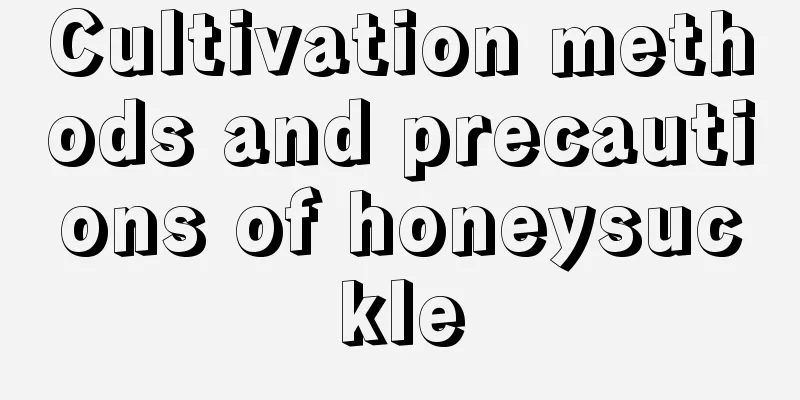Cultivation methods and precautions of honeysuckle

1. Maintenance methods1. Soil: It is suitable for growing in any soil. It has only one requirement for the soil, which is that the soil must have good drainage. If you use relatively sticky soil to grow it, you can add expanded clay to the soil to increase drainage. 2. Watering: For plants maintained in the open field, watering is generally not required unless it is dry weather. If the plant is in a state of drought for a long time, it is best to replenish it with water once a week. If it is a potted plant, it needs to be watered once every two to three days. Don't water too much each time, just water until the soil surface is moist. 3. Fertilization: No fertilizer is needed except during the growing period. During the growth period, nutrients are consumed quickly, so topdressing is needed to increase nutrients. The frequency of fertilization is twice a month. When fertilizing, you should choose fertilizers with richer ingredients. After fertilization, you need to water it immediately. One reason is to avoid fertilizer damage; the other is to allow the fertilizer to blend with the soil for easy absorption by the plant. 4. Light: Its growth cannot be separated from light. The daily light exposure time is at least five hours. If conditions permit, it is best to receive full-day sunlight. The plant needs to be rotated after being cared for for a period of time to prevent the sunny side from growing too tall. 2. Breeding techniques1. Reproduction: It can be propagated by sowing. When the fruits are ripe in October, peel them, dry them and store them. The sowing time is in March. Take out the seeds and soak them in warm water for half a day before sowing. When the seedlings grow to ten centimeters high, you can spray them with Bordeaux liquid to prevent damping-off disease. 2. Pruning: When pruning, keep some branches appropriately to increase the yield. In order to make the branches evenly distributed, you can cut off excess branches in the spring, cutting from the inside to the outside and dividing them into layers, which can also increase the yield. 3. Problem Diagnosis1. Pests: Aphids are pests that plants are more easily infected with. Aphids attack young leaves, causing them to curl and stop growing. If you find that the plants are infected with aphids, you can use aphidicide to eliminate the insects. 2. Diseases: Brown spot disease is common on the leaves of plants, which will weaken the growth of the plants. The peak period of the disease is in August and September every year because it is rainy and humid at this time. After the disease occurs, cut off the diseased leaves and then spray the plants with thiophanate-methyl for treatment. IV. Other issues1. Edibility: It is edible. In addition to being edible, it can also be used as medicine. 2. Toxicity: non-toxic. |
>>: Coral bell cultivation methods and precautions
Recommend
Do roses like the sun? Can they be placed in the sun?
1. Do you like sunbathing? It is a light-loving p...
How to propagate Chinese roses
1. How to breed The most common method of propaga...
Cutting method of osmanthus
Cutting time The best time for cuttings is from m...
Why can't osmanthus trees be planted at home? Can osmanthus trees be planted at home?
Can I plant an osmanthus tree at home? You can pl...
What is the best month to plant millet?
When is millet planted? Millet is generally plant...
Can mulberry trees be planted in the yard?
Can I plant mulberry trees in my yard? Mulberry t...
How to raise blue snowflakes in winter
1. Keep warm Winter is quite cold, so if you want...
When does the desert rose bloom?
1. Which month does it bloom? This plant blooms t...
What are the breeding methods and precautions for Bafanglaicai?
How to breed Bafanglaicai Reproduction method : B...
How to grow dahlias
Soil selection for dahlias Dahlias grow best in l...
Can Lithops survive after blooming?
1. Flowering time Generally speaking, if it is pr...
Varieties and prices of cherry seedlings
1. Varieties There are many varieties of cherry s...
What trees are suitable for roof gardens? What plants are suitable for roof gardens?
The light intensity of the roof garden is relativ...
Cultivation and shaping techniques of bonsai of old persimmon
1. Seed propagation After the fifteenth day of th...
Can the money tree be pruned?
The money tree is a popular indoor plant, loved f...









